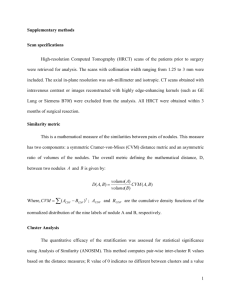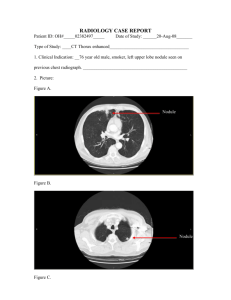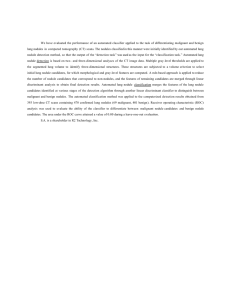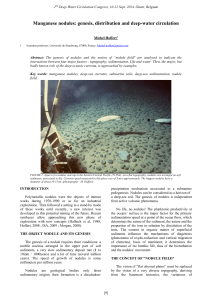Compensation Against Ineffective Nodulation in Soybean P.
advertisement
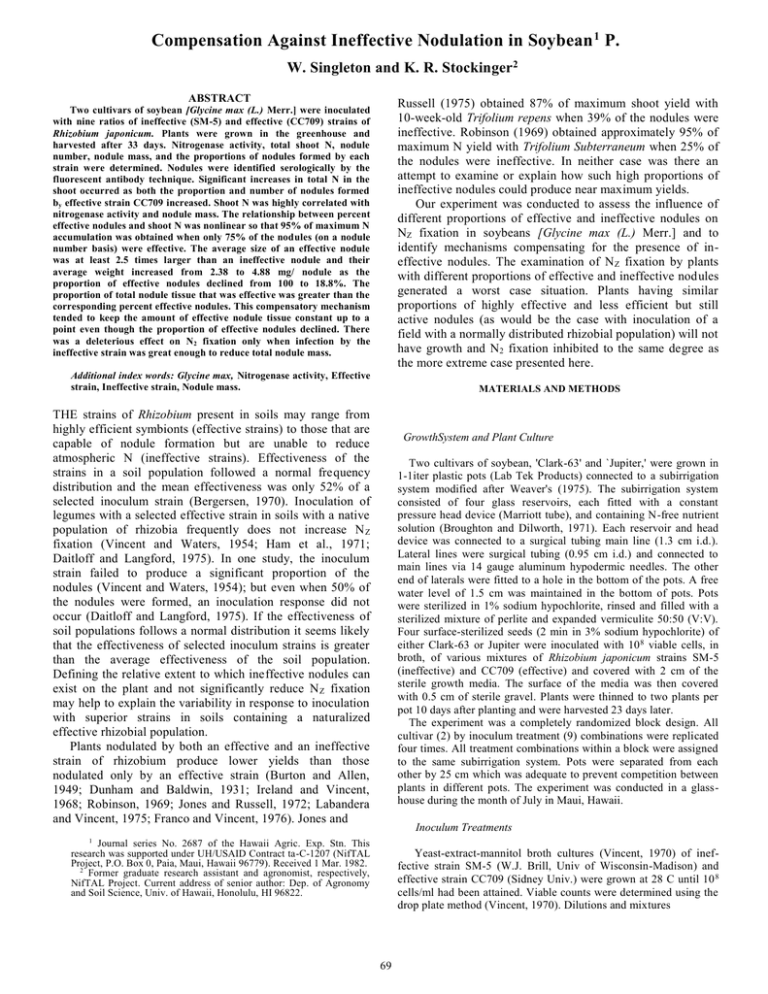
Compensation Against Ineffective Nodulation in Soybean 1 P. W. Singleton and K. R. Stockinger2 ABSTRACT Russell (1975) obtained 87% of maximum shoot yield with 10-week-old Trifolium repens when 39% of the nodules were ineffective. Robinson (1969) obtained approximately 95% of maximum N yield with Trifolium Subterraneum when 25% of the nodules were ineffective. In neither case was there an attempt to examine or explain how such high proportions of ineffective nodules could produce near maximum yields. Our experiment was conducted to assess the influence of different proportions of effective and ineffective nodules on NZ fixation in soybeans [Glycine max (L.) Merr.] and to identify mechanisms compensating for the presence of ineffective nodules. The examination of N Z fixation by plants with different proportions of effective and ineffective nodules generated a worst case situation. Plants having similar proportions of highly effective and less efficient but still active nodules (as would be the case with inoculation of a field with a normally distributed rhizobial population) will not have growth and N2 fixation inhibited to the same degree as the more extreme case presented here. Two cultivars of soybean [Glycine max (L.) Merr.] were inoculated with nine ratios of ineffective (SM-5) and effective (CC709) strains of Rhizobium japonicum. Plants were grown in the greenhouse and harvested after 33 days. Nitrogenase activity, total shoot N, nodule number, nodule mass, and the proportions of nodules formed by each strain were determined. Nodules were identified serologically by the fluorescent antibody technique. Significant increases in total N in the shoot occurred as both the proportion and number of nodules formed by effective strain CC709 increased. Shoot N was highly correlated with nitrogenase activity and nodule mass. The relationship between percent effective nodules and shoot N was nonlinear so that 95% of maximum N accumulation was obtained when only 75% of the nodules (on a nodule number basis) were effective. The average size of an effective nodule was at least 2.5 times larger than an ineffective nodule and their average weight increased from 2.38 to 4.88 mg/ nodule as the proportion of effective nodules declined from 100 to 18.8%. The proportion of total nodule tissue that was effective was greater than the corresponding percent effective nodules. This compensatory mechanism tended to keep the amount of effective nodule tissue constant up to a point even though the proportion of effective nodules declined. There was a deleterious effect on N2 fixation only when infection by the ineffective strain was great enough to reduce total nodule mass. Additional index words: Glycine max, Nitrogenase activity, Effective strain, Ineffective strain, Nodule mass. MATERIALS AND METHODS THE strains of Rhizobium present in soils may range from highly efficient symbionts (effective strains) to those that are capable of nodule formation but are unable to reduce atmospheric N (ineffective strains). Effectiveness of the strains in a soil population followed a normal frequency distribution and the mean effectiveness was only 52% of a selected inoculum strain (Bergersen, 1970). Inoculation of legumes with a selected effective strain in soils with a native population of rhizobia frequently does not increase N Z fixation (Vincent and Waters, 1954; Ham et al., 1971; Daitloff and Langford, 1975). In one study, the inoculum strain failed to produce a significant proportion of the nodules (Vincent and Waters, 1954); but even when 50% of the nodules were formed, an inoculation response did not occur (Daitloff and Langford, 1975). If the effectiveness of soil populations follows a normal distribution it seems likely that the effectiveness of selected inoculum strains is greater than the average effectiveness of the soil population. Defining the relative extent to which ineffective nodules can exist on the plant and not significantly reduce N Z fixation may help to explain the variability in response to inoculation with superior strains in soils containing a naturalized effective rhizobial population. Plants nodulated by both an effective and an ineffective strain of rhizobium produce lower yields than those nodulated only by an effective strain (Burton and Allen, 1949; Dunham and Baldwin, 1931; Ireland and Vincent, 1968; Robinson, 1969; Jones and Russell, 1972; Labandera and Vincent, 1975; Franco and Vincent, 1976). Jones and GrowthSystem and Plant Culture Two cultivars of soybean, 'Clark-63' and `Jupiter,' were grown in 1-1iter plastic pots (Lab Tek Products) connected to a subirrigation system modified after Weaver's (1975). The subirrigation system consisted of four glass reservoirs, each fitted with a constant pressure head device (Marriott tube), and containing N-free nutrient solution (Broughton and Dilworth, 1971). Each reservoir and head device was connected to a surgical tubing main line (1.3 cm i.d.). Lateral lines were surgical tubing (0.95 cm i.d.) and connected to main lines via 14 gauge aluminum hypodermic needles. The other end of laterals were fitted to a hole in the bottom of the pots. A free water level of 1.5 cm was maintained in the bottom of pots. Pots were sterilized in 1% sodium hypochlorite, rinsed and filled with a sterilized mixture of perlite and expanded vermiculite 50:50 (V:V). Four surface-sterilized seeds (2 min in 3% sodium hypochlorite) of either Clark-63 or Jupiter were inoculated with 10 8 viable cells, in broth, of various mixtures of Rhizobium japonicum strains SM-5 (ineffective) and CC709 (effective) and covered with 2 cm of the sterile growth media. The surface of the media was then covered with 0.5 cm of sterile gravel. Plants were thinned to two plants per pot 10 days after planting and were harvested 23 days later. The experiment was a completely randomized block design. All cultivar (2) by inoculum treatment (9) combinations were replicated four times. All treatment combinations within a block were assigned to the same subirrigation system. Pots were separated from each other by 25 cm which was adequate to prevent competition between plants in different pots. The experiment was conducted in a glasshouse during the month of July in Maui, Hawaii. Inoculum Treatments 1 Journal series No. 2687 of the Hawaii Agric. Exp. Stn. This research was supported under UH/USAID Contract ta-C-1207 (NifTAL Project, P.O. Box 0, Paia, Maui, Hawaii 96779). Received 1 Mar. 1982. 2 Former graduate research assistant and agronomist, respectively, NifTAL Project. Current address of senior author: Dep. of Agronomy and Soil Science, Univ. of Hawaii, Honolulu, HI 96822. Yeast-extract-mannitol broth cultures (Vincent, 1970) of ineffective strain SM-5 (W.J. Brill, Univ of Wisconsin-Madison) and effective strain CC709 (Sidney Univ.) were grown at 28 C until 10 8 cells/ml had been attained. Viable counts were determined using the drop plate method (Vincent, 1970). Dilutions and mixtures 69 2 CR OP SC IE NC E, VOL. 23, J ANUA R Y-FE BR UAR Y 1983 of the two cultures were made to produce ratios of viable cells (SM-5:CC709): 10 8:0; 10 8:10 2; 10 8:103; 108:10 4; 10 8:105; 10 8:10 6; 108:10 8; 10 6:108; 0:10 8. Harvest Plants were harvested by block; shoots were cut at the surface of the growth media then dried at 60 C. The dried shoots were ground, digested in sulfuric acid, and ammonium was determined by the colorimetric method of Mitchell (1972). Roots with media removed were incubated for 1.5 hours in 1.1 liter plastic containers with 10% acetylene. Ethylene production was determined by gas chromatography. Nodules of all root systems were removed and freeze-dried to constant weight. Serological Identification of Nodules Twenty freeze-dried nodules from each treatment combination were randomly selected for identification. The bacteroid zone of the nodules was touched to a drop of saline solution on a microscope slide. The cells were heat-fixed, treated with gelatin-rhodamine isothiocyanate (Bohlool and Schmidt, 1968) and a drop of a 1:10 dilution of CC709 fluorescent antibody conjugated according to methods described by Schmidt et al. (1968). The slides were incubated in a moist chamber for 30 min, washed in saline solution for 15 min, then in deionized water for 5 min, dried and checked for positive reactions by epi-fluorescence microscopy. Doubly infected nodules were counted as effective nodules. The relationship that was predicted between the average weight of an effective nodule and the proportion of effective nodules was evaluated by collecting sufficient nodules at random from each treatment to obtain five effective nodules per replication. Individual nodules were weighed on an analytical balance and later typed to determine which strain formed the nodule. Partitioning of Nodule Mass into Effective And Ineffective Components Nodule mass can be partitioned between its effective and ineffective components in a number of ways. First, the average weight of a nodule can be determined in the two pure culture treatments. These figures, 0.96 mg/nodule for SM-5 and 2.38 mg/nodule for CC709, can be multiplied by the number of nodules formed by each strain in intermediate treatments. However, the sum of the two calculated nodule mass components was always less than the observed total nodule mass. Another method (method 1, Table 1) divides total nitrogenase activity measured in intermediate treatments by the specific nitrogenase activity when 100% of the nodules are effective. The result estimates effective nodule mass since ineffective nodules do not reduce acetylene. Effective nodule mass may also be determined by the difference between ineffective mass (calculated from ineffective number and the weight of an average ineffective nodule in pure culture) and total nodule mass (method 2, Table 1). RESULTS AND DISCUSSION When legumes are inoculated by more than one strain of rhizobium which results in the production of nodules varying in effectiveness, N2 fixation is reduced compared to plants with only highly effective nodules (Robinson, 1969; Jones and Russell, 1975). Nodulation by strains with a range of effectiveness is the norm when legumes are grown in soils with a native rhizobial population (Bergersen, 1970). The extent to which the host legume can compensate for ineffective nodulation has not been quantified and such data have significant implications. For example, the degree to which inoculation with superior strains will increase N yield in soils with an inferior native rhizobial population will be determined by the host's ability to compensate for the presence of some nodules having reduced efficiency. Intuitively, the deleterious effect that some ineffective nodules would have on N 2 fixation is minimized because host photosynthate would not be respired by these nodules in the reduction of atmospheric nitrogen. The loss of photosynthate to ineffective nodulation would be that required for nodule formation and maintenance of ineffective bacteriods. Minchin and Pate (1973) estimated that only 5.0% of plant carbon was used in nodule structure, while Bond (1941) estimated that 16.0% of total plant carbon was respired in N 2 fixation. Only when ineffective nodulation is present at a level that causes a reduction in the amount of effective nodule tissue should a serious reduction in N 2 fixation occur. This reduction is due to insufficiency of effective nodule mass rather than a reduction in carbon available to effective nodules due to useless respiration by ineffective nodules. The data collected in this study make it possible to partition total nodule mass into its effective and ineffective components and explains why significant proportions of nodules can be ineffective and not appreciably reduce N 2 fixation. From Fig. 1 (data for both cultivars were pooled), it can be seen that a decline in both the proportion and number of effective nodules does not result in a proportional decline in N accumulation. Approximately 95% of maximum N yield was attained when 75% of the nodules were effective. The number of effective nodules (175) producing 95% of maximum N yield was only 80% of the number of effective nodules (241) when only CC709 inoculum was used. Shoot N was highly correlated with both nodule mass and nitrogenase activity (Fig. 2). Therefore, reduced proportions and numbers of effective nodules did not result in a proportional decline in nodule mass nor total nitrogenase 3 SINGLETON & STOCKINGER: INEFFECTIVE NODULATION IN SOYBEAN activity (Fig. 3). This figure shows that both nodule mass and nitrogenase activity remained near maximum with large reductions in the number of effective nodules. For NZ fixation to remain at a high level with reduced numbers of effective nodules either the specific nitrogenase activity of effective nodules increases as the number of effective nodules declines or the proportion of nodule mass that is effective is not the same as the proportion of nodules that were effective. Evidence points to the latter hypothesis and this is explained by two phenomena. First, the size of effective nodules is much larger than ineffective nodules. In pure culture treatments the average weight of a nodule was 2.38 mg/nodule for CC709 and 0.96 mg/nodule for SM-5. Second, the average size of an effective nodule increases as the proportion of effective nodules declines (Fig. 4). Using data for nodule number and nodule mass, the average size of nodules produced by each strain in the pure culture treatments can be estimated. Since the size of an effective nodule was 2.5 times that of an effective nodule, the proportion of nodules that are effective does not directly estimate the proportion of nodule mass that is effective. For example, if it is assumed that average nodule size does not vary with the treatments, then when 75% of the nodules are effective at least 88% of the nodule mass is effective. However, when the average nodule size of each strain in pure culture is multiplied by the number of nodules formed by each strain to compute total nodule mass, the figures were consistently less than measured total nodule mass. This difference is accounted for by the fact that the average size of effective nodules varies inversely with the proportion of effective nodules. Effective nodule mass can be derived by assuming a constant specific nodule activity (126 µM C2H4/g hour) as determined when all nodules are effective. Total nodule activity divided by specific activity equals effective nodule mass (Table 1). The amount of effective nodule tissue can also be derived by subtracting ineffective nodule mass (number of ineffective nodules multiplied by 0.96 mg/nodule) from total nodule mass. Table 1 shows that these two independent methods result in essentially the same figure for effective nodule mass. In both cases, the proportion of nodules formed by effective strain TAL 378 seriously underestimates the proportion of nodule mass that is effective. The difference between the percent effective nodules and the proportion of total nodule mass that is effective increases as the percent effective nodules declines. Using effective nodule mass determined in Table 1 by method 1 and effective nodule number, an estimate of the 72 CROP SCIENCE, VOL. 23, JANUARY-FEBRUARY 1983 ACKNOWLEDGMENTS We are grateful to D.B. Bartholomew and B.B. Bohlool for their editorial review and technical comments and P. Nakao for assistance in serology. The conclusions in this paper do not necessarily represent those of the granting agency. REFERENCES † Calculated by dividing total nodule nitrogenase activity (uMC2H4/pot•h) by specific activity (126 uM C2H4/g nodule-h). ‡ Calculated by subtracting the estimate of ineffective nodule mass (number of ineffective nodules multiplied by 0.96 mg/nodule from total nodule mass. Numbers in parentheses are the percentages of total nodule mass that is effective. average mass of an effective nodule may be made. The average mass of an effective nodule varies inversely with the proportion of effective nodules (Fig. 4). This curve shows that the average size of effective nodules increases almost two-fold as the proportion of effective nodules declines from 100 to 14%. There is, therefore a compensatory response to the reduced numbers of effective nodules that result from competition by an ineffective strain. In conclusion, there are two reasons for the failure of large proportions of ineffective nodules to reduce N 2 fixation in soybean. First, due to the larger size of effective nodules, the per cent effective nodules seriously underestimates the proportion of nodule mass that is effective. Second, the average size of effective nodules varies inversely with the proportion of effective nodules. Therefore, to a degree, reduced numbers of effective nodules are compensated for by an increased size of effective nodules. This compensatory mechanism resulted in the maintenance of a high effective nodule mass when competition from an ineffective strain reduced the number and proportion of effective nodules. Perhaps the host channels photosynthate selectively to effective nodules for nodule growth. Reduced numbers of effective nodules causes photosynthate to be allocated between fewer nodules and results in an increased size. This study emphasizes that the parameter most closely related to symbiotic N2 fixation is nodule mass. This is true even when the plant is nodulated by more than one strain, one of which is completely ineffective. Only when the presence of ineffective nodules causes total nodule mass and effective nodule mass to decline is Nz fixation affected. 1. Bergersen, F.J. 1970. Some Australian studies relating to long term effects of the inoculation of legume seed. Plant Soil 32:727-736. 2. Bohlool, B.B., and E.L. Schmidt. 1968. Nonspecific staining: its control in immunofluorescence examination of soil. Science 162:10121014. 3. Bond, G. 1941. Symbiosis of leguminous plants and nodule bacteria. Ann. Bot. 15:95-108. 4. Broughton, W.J., and M.J. Dilworth. 1971. Control of leghemoglobin synthesis in snakebean. Biochem. J., 125:1075-1080. 5. Burton, J.C. and O.N. Allen. 1949. Inoculation of crimson clover with mixtures of rhizobia strains. Soil Sci. Soc. Am. Proc. 14:191-195. 6. Daitloff, A., and S. Langford. 1975. Effective natural nodulation of peanuts in Queensland. Queensl. J. Agic. Anim. Sci. 32(1):95-100. 7. Dunham, D.H., and I.L. Baldwin. 1931. Double infection of leguminous plants with good and poor strains of rhizobia. Soil Sci. 32:235249. 8. Franco, A.A., and J.M. Vincent. 1976. Competition among rhizobial strains for the colonization and nodulation of two tropical legumes. Plant Soil 45(1):27-48. 9. Ham, G.E., V.B. Cardwell, and H.W. Johnson. 1971. Evaluation of Rhizodium japonicum inoculantsin soils containing naturalized populations of rhizobia. Agron. J. 63:301-303. 10. Ireland, J.A., and J.M. Vincent. 1968. A quantitative study of competition for nodule formation. 9th Int. Congress of Soil Sci. Trans. 2:8593 11. Jones, D.G., and P.E. Russell. 1972. The application of immunofluorescence techniques to host plant/nodule bacteria selectivity experiments using Trifolium repens. Soil Biol. Biochem. 4:277-282. 12. Labandera, C.A., and J.M. Vincent. 1975. Competition between an introduced strain and native Uruguayan strains of Rhizobium trifolit. Plant Soil, 42(2):327-347. 13. Minchin, F.R., and J.S. Pate. 1973. The carbon balance of a legume and the functional economy of its root nodules. J. Exp. Bot. 24:259271. 14. Mitchell, H.L. 1972. The microdetermination of nitrogen in plant tissues. J. Assoc. Off. Anal. Chem. 55(1):1-3. 15. Robinson, A.C. 1969. Competition between effective and ineffective strains of Rhizobium trifolii in the nodulation of Trifolium subterraneum. Aust. J. Agric. Res. 20:827-841. 16. Schmidt, E.L., R.O. Bankole, and B.B. Bohlool. 1968. Fluorescent antibody approach to the study of rhizobia in soil. J. Bacteriol. 95:19871992. 17. Vincent, J.M. 1970. A Manual for the Practical Study of Root-Nodule Bacteria. Burgess and Son Ltd., Berkshire, Great Britain. 18. ----, and L.M. Waters. 1954. The root-nodule bacteria as factors in clover establishment in the red basaltic soils of the Lismore District, New South Wales. Aust. J. Agric. Res. 5:61-77. 19. Weaver, R.W. 1975. Growing plants for rhizobium effectiveness tests. Soil Biol. Biochem. 7:77-78.
